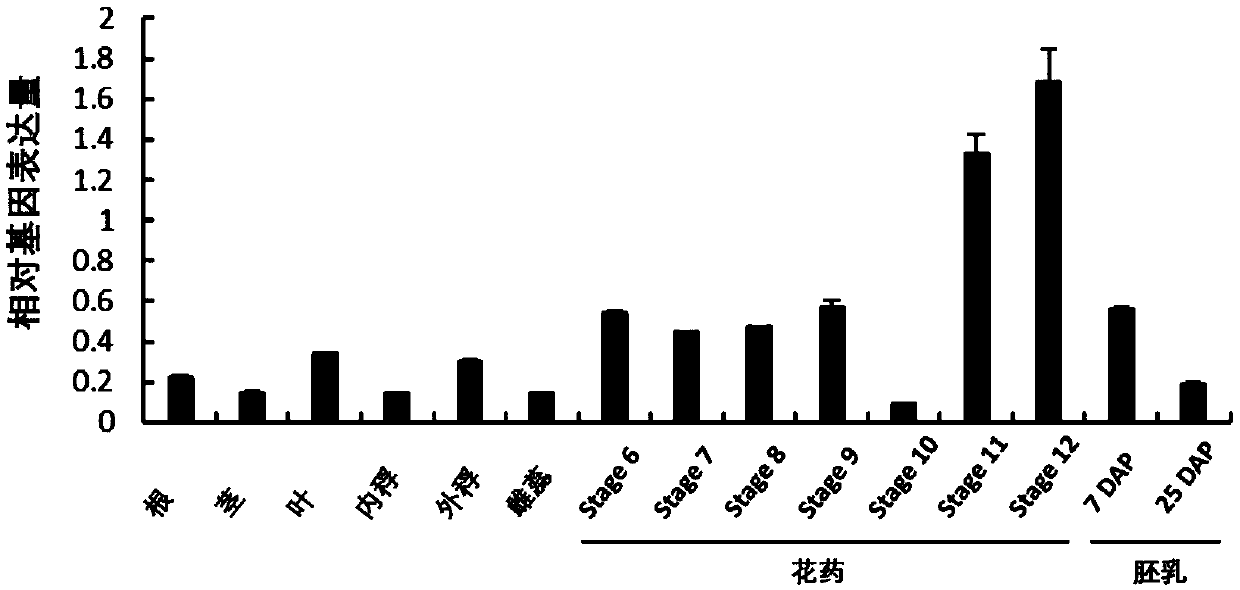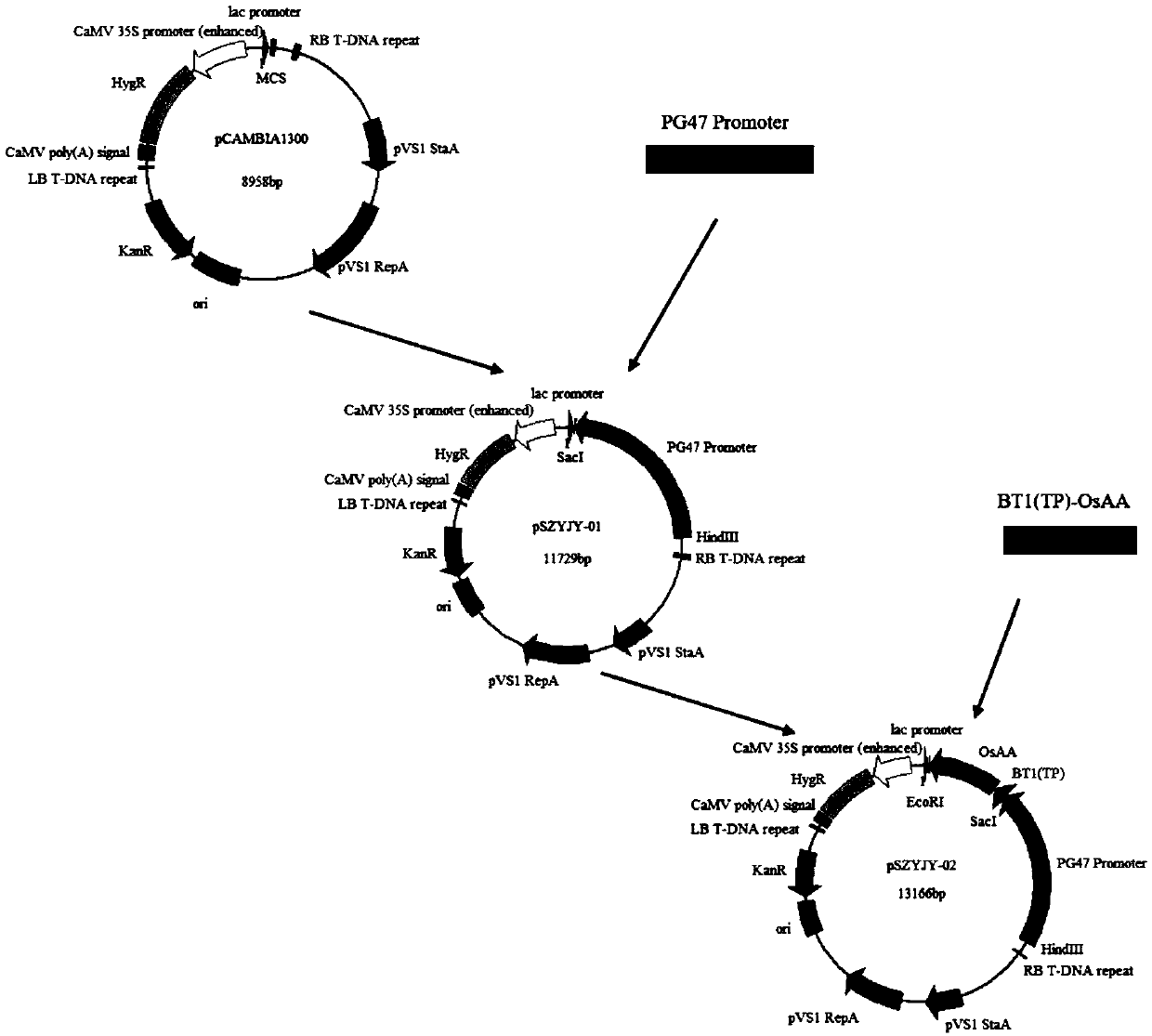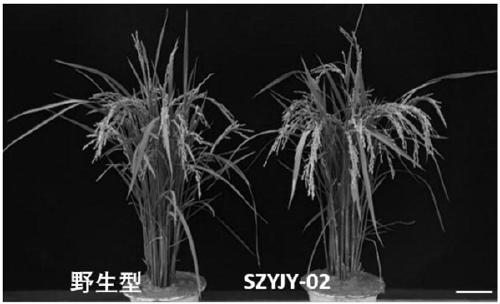Rice alpha-amylase and coding genes and application thereof
A technology of amylase and rice, which is applied in the fields of application, hydrolase, genetic engineering, etc., and can solve problems such as few reports
- Summary
- Abstract
- Description
- Claims
- Application Information
AI Technical Summary
Problems solved by technology
Method used
Image
Examples
Embodiment 1
[0064] Example 1. Acquisition of rice α-amylase gene OsAA and analysis of its tissue expression pattern
[0065] 1. Extraction of rice Nipponbare RNA
[0066] Use the Trizol Reagent method to extract Nipponbare RNA: weigh each tissue of Nipponbare (root, stem, leaf, pistil, lemma, pada, anther and endosperm) into liquid nitrogen, take it out, grind it into powder with a mortar, and then add 1ml TrizolReagent (TransGen Biotech), shake vigorously, then add 0.2ml chloroform, shake vigorously for 15s, let stand at room temperature for 3min; centrifuge at 12000rmp 4°C for 15min; carefully take out the centrifuge tube from the centrifuge, transfer 0.6ml supernatant to another Put in a new centrifuge tube; add an equal volume of isopropanol to the supernatant, invert the centrifuge tube up and down to mix thoroughly, and let it stand at room temperature for 10 minutes; centrifuge at 12000rmp 4°C for 10 minutes; discard the supernatant, and a white gelatinous precipitate appears at th...
Embodiment 2
[0085] Cloning of embodiment 2, PG47 promoter and BT1 transit peptide gene
[0086] The PG47 promoter (as shown in SEQ ID NO: 2 in the sequence listing) and the BT1 transit peptide gene (as shown in SEQ ID NO: 3 in the sequence listing) were obtained from the pZhen18B vector plasmid (Chang, Z., Chen, Z., Wang, N., Xie, G., Lu, J., Yan, W., Zhou, J., Tang, X., and Deng, X.W.. Construction of a male sterility system for hybrid rice breeding and seed production using a nuclear Amplified from male sterilitygene.Proc Natl Acad Sci USA.2016.113,14145-14150.). The primers required for PG47 promoter amplification are shown in SEQ ID NO: 9-10 in the sequence table, wherein the forward primer has a HindIII restriction site, and the reverse primer has a SacI restriction site; BT1 transit peptide gene The primers required for amplification are shown in SEQ ID NO: 11-12 in the sequence listing, wherein the forward primer has a SacI restriction site. The primers were designed using Primer...
Embodiment 3
[0089] Example 3, Construction of recombinant expression vector pSZYJY-02 containing rice α-amylase gene OsAA
[0090] 1. Construction of recombinant expression vector pSZYJY-01 containing rice PG47 promoter
[0091] Insert the PG47 promoter of the amplified product in Example 2 into the EcoRI and SacI restriction sites of the pCAMBIA1300 vector, and the construction process is as follows figure 2 shown. That is, the amplified product of the PG47 promoter and the pCAMBIA1300 vector were digested with HindIII and SacI respectively and recovered, and then the recovered product was ligated, and the ligation system was as follows:
[0092] PG47 promoter PCR product (50ng) 2ul
[0093] Digested pCAMBIA1300 vector product (50ng) 2ul
[0094] 5X In-Fusion HD Enzyme Premix (TaKaRa) 1ul
[0095] Connect at 50°C for 20 minutes.
[0096] All the ligation products above were heat-shock transformed into Escherichia coli competent cells, positive clones were selected for sequencing, and...
PUM
 Login to View More
Login to View More Abstract
Description
Claims
Application Information
 Login to View More
Login to View More - R&D
- Intellectual Property
- Life Sciences
- Materials
- Tech Scout
- Unparalleled Data Quality
- Higher Quality Content
- 60% Fewer Hallucinations
Browse by: Latest US Patents, China's latest patents, Technical Efficacy Thesaurus, Application Domain, Technology Topic, Popular Technical Reports.
© 2025 PatSnap. All rights reserved.Legal|Privacy policy|Modern Slavery Act Transparency Statement|Sitemap|About US| Contact US: help@patsnap.com



